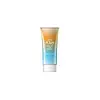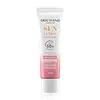Skin Aqua Tone Up UV Essence SPF 50+ PA++++ Versus Srichand Sunlution Skin Whitening Sunscreen SPF 50+
What's inside
What's inside
 Key Ingredients
Key Ingredients

 Benefits
Benefits

 Concerns
Concerns

 Ingredients Side-by-side
Ingredients Side-by-side

Water
Skin ConditioningAlcohol Denat.
AntimicrobialEthylhexyl Methoxycinnamate
UV AbsorberButylene Glycol
HumectantDiphenylsiloxy Phenyl Trimethicone
Skin ConditioningDiethylamino Hydroxybenzoyl Hexyl Benzoate
UV FilterTitanium Dioxide
Cosmetic ColorantSodium Hyaluronate
HumectantSodium Ascorbyl Phosphate
AntioxidantOenothera Biennis Flower Extract
AstringentBarm Extract
Skin ConditioningBis-PEG-18 Methyl Ether Dimethyl Silane
EmollientMethyl Methacrylate Crosspolymer
Bis-Ethylhexyloxyphenol Methoxyphenyl Triazine
Skin ConditioningAcrylates Copolymer
Polysorbate 60
EmulsifyingAcrylates/C10-30 Alkyl Acrylate Crosspolymer
Emulsion StabilisingMelaleuca Alternifolia Leaf Oil
AntioxidantAmmonium Acryloyldimethyltaurate/Vp Copolymer
Silica
AbrasivePEG-12 Dimethicone
Skin ConditioningPolystyrene
Polyvinyl Alcohol
Disodium EDTA
Xanthan Gum
EmulsifyingAlumina
AbrasiveBHT
AntioxidantPolyglyceryl-2 Triisostearate
EmulsifyingSynthetic Fluorphlogopite
Tin Oxide
AbrasiveCI 45380
Cosmetic ColorantBlue 1 Lake
Cosmetic ColorantParfum
MaskingWater, Alcohol Denat., Ethylhexyl Methoxycinnamate, Butylene Glycol, Diphenylsiloxy Phenyl Trimethicone, Diethylamino Hydroxybenzoyl Hexyl Benzoate, Titanium Dioxide, Sodium Hyaluronate, Sodium Ascorbyl Phosphate, Oenothera Biennis Flower Extract, Barm Extract, Bis-PEG-18 Methyl Ether Dimethyl Silane, Methyl Methacrylate Crosspolymer, Bis-Ethylhexyloxyphenol Methoxyphenyl Triazine, Acrylates Copolymer, Polysorbate 60, Acrylates/C10-30 Alkyl Acrylate Crosspolymer, Melaleuca Alternifolia Leaf Oil, Ammonium Acryloyldimethyltaurate/Vp Copolymer, Silica, PEG-12 Dimethicone, Polystyrene, Polyvinyl Alcohol, Disodium EDTA, Xanthan Gum, Alumina, BHT, Polyglyceryl-2 Triisostearate, Synthetic Fluorphlogopite, Tin Oxide, CI 45380, Blue 1 Lake, Parfum
Water
Skin ConditioningButyl Methoxydibenzoylmethane
UV AbsorberEthylhexyl Salicylate
UV AbsorberEthylhexyl Triazone
UV AbsorberDibutyl Adipate
EmollientButylene Glycol
HumectantNeopentyl Glycol Diheptanoate
EmollientSilica
AbrasiveDiethylamino Hydroxybenzoyl Hexyl Benzoate
UV FilterCetearyl Alcohol
EmollientPhenoxyethanol
PreservativeGlyceryl Stearate
EmollientPEG-100 Stearate
Potassium Cetyl Phosphate
EmulsifyingBis-Ethylhexyloxyphenol Methoxyphenyl Triazine
Skin ConditioningDimethicone
EmollientChlorphenesin
AntimicrobialTitanium Dioxide
Cosmetic ColorantAcrylates/C10-30 Alkyl Acrylate Crosspolymer
Emulsion StabilisingNiacinamide
SmoothingCetearyl Glucoside
EmulsifyingVp/Hexadecene Copolymer
Potassium Hydroxide
Buffering3-O-Ethyl Ascorbic Acid
Skin ConditioningCI 77163
Cosmetic ColorantTocopheryl Acetate
AntioxidantDisodium EDTA
Carbomer
Emulsion StabilisingEthylhexylglycerin
Skin ConditioningPropanediol
SolventCaprylic/Capric Triglyceride
MaskingBuddleja Officinalis Flower Extract
UV FilterCetyl Palmitate
EmollientPolysorbate 80
EmulsifyingSorbitan Stearate
EmulsifyingSodium Benzoate
MaskingCitric Acid
BufferingHydrogenated Lecithin
EmulsifyingTocopherol
AntioxidantPalmitoyl Tetrapeptide-10
Skin ConditioningWater, Butyl Methoxydibenzoylmethane, Ethylhexyl Salicylate, Ethylhexyl Triazone, Dibutyl Adipate, Butylene Glycol, Neopentyl Glycol Diheptanoate, Silica, Diethylamino Hydroxybenzoyl Hexyl Benzoate, Cetearyl Alcohol, Phenoxyethanol, Glyceryl Stearate, PEG-100 Stearate, Potassium Cetyl Phosphate, Bis-Ethylhexyloxyphenol Methoxyphenyl Triazine, Dimethicone, Chlorphenesin, Titanium Dioxide, Acrylates/C10-30 Alkyl Acrylate Crosspolymer, Niacinamide, Cetearyl Glucoside, Vp/Hexadecene Copolymer, Potassium Hydroxide, 3-O-Ethyl Ascorbic Acid, CI 77163, Tocopheryl Acetate, Disodium EDTA, Carbomer, Ethylhexylglycerin, Propanediol, Caprylic/Capric Triglyceride, Buddleja Officinalis Flower Extract, Cetyl Palmitate, Polysorbate 80, Sorbitan Stearate, Sodium Benzoate, Citric Acid, Hydrogenated Lecithin, Tocopherol, Palmitoyl Tetrapeptide-10
 Reviews
Reviews

Ingredients Explained
These ingredients are found in both products.
Ingredients higher up in an ingredient list are typically present in a larger amount.
Acrylates/C10-30 Alkyl Acrylate Crosspolymer is a synthetic polymer. It is used to thicken and improve the texture of products. Due to its properties, it can prevent water and oil ingredients from separating.
You might know this ingredient as Tinosorb S or Bemotrizinol. It is a UV filter that covers both UVA and UVB rays.
This ingredient has two peak UV absorption peaks ( 310 and 340 nm) and is able to absorb both UV-A and UV-B rays. This ingredient works by preventing UV rays from reaching and damaging your skin.
On top of that - it is highly photostable and helps prevent the photodegration of other sunscreen ingredients such as avobenzone.
Tinosorb S is allowed in the EU, Australia, and Asia. It is close to being approved by the FDA and we'll hopefully get this ingredient in the U.S. by late 2025.
Fun fact: Tinosorb S is the most effective UV absorber at maximum concentration (measured by SPF) permitted in the EU.
This ingredient is oil-soluble, so your oil-cleansers will take this right off at night.
Learn more about Bis-Ethylhexyloxyphenol Methoxyphenyl TriazineButylene Glycol (or BG) is used within cosmetic products for a few different reasons:
Overall, Butylene Glycol is a safe and well-rounded ingredient that works well with other ingredients.
Though this ingredient works well with most skin types, some people with sensitive skin may experience a reaction such as allergic rashes, closed comedones, or itchiness.
Learn more about Butylene GlycolDiethylamino Hydroxybenzoyl Hexyl Benzoate (DHHB) is a chemical UV-A absorber. It is formulated for high UVA protection (320-400 nm).
DHHB is well-liked for:
DHHB has been approved by the EU, Japan, Taiwan, and South America for use up to 10%. Unfortunately, it has not been approved for use in the US or Canada due to slow regulatory processes.
This ingredient is soluble in oils, fats, and lipids.
Learn more about Diethylamino Hydroxybenzoyl Hexyl BenzoateDisodium EDTA plays a role in making products more stable by aiding other preservatives.
It is a chelating agent, meaning it neutralizes metal ions that may be found in a product.
Disodium EDTA is a salt of edetic acid and is found to be safe in cosmetic ingredients.
Learn more about Disodium EDTASilica, also known as silicon dioxide, is a naturally occurring mineral. It is used as a fine, spherical, and porous powder in cosmetics.
Though it has exfoliant properties, the function of silica varies depending on the product.
The unique structure of silica enhances the spreadability and adds smoothness, making it a great texture enhancer.
It is also used as an active carrier, emulsifier, and mattifier due to its ability to absorb excess oil.
In some products, tiny microneedles called spicules are made from silica or hydrolyzed sponge. When you rub them in, they lightly polish away dead skin layers and enhance the penetration of active ingredients.
Learn more about SilicaTitanium dioxide is a mineral UV filter widely used in sunscreens and cosmetics.
It is one of only two UV filters officially classified as “mineral” by regulatory agencies, the other being zinc oxide.
Titanium dioxide provides broad-spectrum protection mostly in the UVB and UVAII range, with some protection in the UVAI range.
While its UVA protection isn’t as strong as zinc oxide’s, the difference is minor.
A common myth is that mineral UV filters reflect UV light. However, modern research shows titanium dioxide absorbs UV radiation like chemical filters (~95% absorption & 5% reflection).
Thanks to its non-irritating nature, titanium dioxide is suitable for sensitive, acne-prone, or redness-prone skin. It is unlikely to cause "eye sting" like other sunscreen ingredients.
A major drawback of this ingredient is its white cast and thick texture. This is why mineral sunscreens often leave a white cast and are less cosmetically elegant than chemical/hybrid sunscreens.
To improve white cast and spreadability, micronized or nano-sized titanium dioxide is often used.
There are ongoing concerns surrounding nano-titanium oxide's impact on marine ecosystems.
There is no conclusive evidence that any form of titanium oxide (or any other sunscreen ingredients) will cause harm to marine ecosystems or coral reefs. The science is still developing but many consumers are keeping a close eye on this issue.
Please note, many destinations have reef-safety sunscreen rules. For instance, the U.S. Virgin Islands advises all visitors to use non-nano mineral sunscreens.
Nano mineral sunscreens once raised safety concerns about absorption into skin.
Extensive research has shown that they do not penetrate healthy or damaged skin; they remain safely on the surface and the top layer of dead skin (stratum corneum).
You'll likely find titanium dioxide bundled with alumina, silica, or dimethicone. These ingredients help make titanium dioxide highly photostable; this prevents it from interacting with other formula components under UV light.
Learn more about Titanium DioxideWater. It's the most common cosmetic ingredient of all. You'll usually see it at the top of ingredient lists, meaning that it makes up the largest part of the product.
So why is it so popular? Water most often acts as a solvent - this means that it helps dissolve other ingredients into the formulation.
You'll also recognize water as that liquid we all need to stay alive. If you see this, drink a glass of water. Stay hydrated!
Learn more about Water